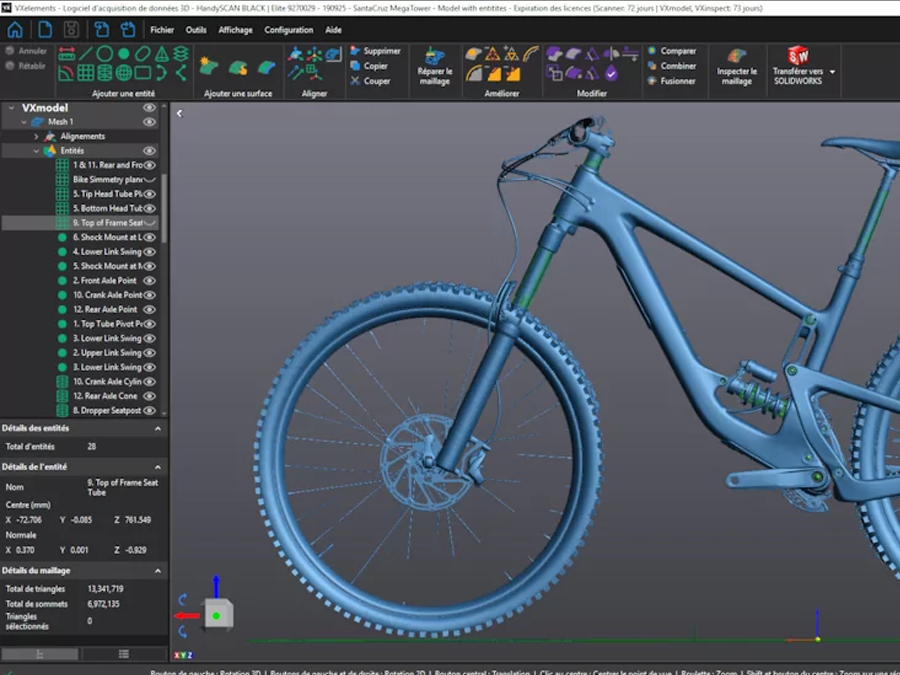Carbon frames
- by sava-bicycles Admin
-

When buying a new bike, are you also wondering what frame material you should choose? Aluminum, carbon or steel? The answer is quite simple. Just like when building a house, for example, you can't combine all three key values - fast, cheap, quality - you can't practically combine the three main requirements for a bike frame - low weight, high frame stiffness and low price. There is no point in writing about why a bike should weigh little and cost little. It's different with frame stiffness. This is sometimes a neglected feature because it is not "at a glance" visible. This (torsional = in torsion) stiffness tells us how much our bike is able to transfer the force generated by our pedaling to the front. Try to imagine how you would ride a bike made of jelly. Probably badly. It would twist under you instead of going forward. That's why frame strength is one of the key, if at first sight invisible, parameters.
Carbon
A carbon frame is the best at two of the three key characteristics mentioned above. It is lightweight and has high stiffness. What's more, this stiffness doesn't wear off over time. Unlike aluminium, carbon does not soften with age. So it's still as stiff as day one. Another nice feature is that a carbon frame absorbs little vibration, so you get less muscle fatigue when riding than on bikes with aluminum or steel frames. The downside is the higher price. Fortunately, Sava has eliminated this single drawback of carbon frames with its efficient manufacturing and direct sales. That's why Sava carbon-framed bikes are priced at the price of aluminum frames.
But carbon wheels also don't have the same quality. It depends on the density of the fibers, the carbon content. The strength of your frame then depends on these values. Each company has their own commercial names for the carbon they use to make carbon frames for their bikes, but the basic division is as follows:
T300 - a commonly used carbon for making wheels, but also drones or automotive, 4 times stronger than steel, Sava does not use it. Tensile strength 3530 MPa, density 1.76 g/cm2.
T700 - used for best wheels, special car parts, high strength and low weight requirements. The trade name for Sava wheels is HTS carbon. Tensile strength 5490 MPa, density 1.8 g/cm2.
T800 - Sava uses on its top models, other uses mainly aerospace and aviation, highest strength at lowest weight, Trade name for Sava UTS carbon. Tensile strength 5880 MPa, density 1.8 g/cm2.
Aluminium
Aluminium is the most common material for wheel frames. It has the advantage of lower weight compared to a steel frame. But higher against carbon. Aluminum frames are cheap. However, they have lower stiffness and over time your frame will "soften". It will twist slightly and therefore cost you more to ride. That's why aluminium is primarily used on cheap bikes.
Steel
The oldest material used in the manufacture of bicycles. It is stronger than aluminium, but it is also heavier. Steel will also rust, so you need to be careful about the finish of the frame. That's why steel is now used for the cheapest kids' bikes, or special retro models for the fancier bikes. You hardly see steel on regular bikes anymore.
Carbon
A carbon frame is the best at two of the three key characteristics mentioned above. It is lightweight and has high stiffness. What's more, this stiffness doesn't wear off over time. Unlike aluminium, carbon does not soften with age. So it's still as stiff as day one. Another nice feature is that a carbon frame absorbs little vibration, so you get less muscle fatigue when riding than on bikes with aluminum or steel frames. The downside is the higher price. Fortunately, Sava has eliminated this single drawback of carbon frames with its efficient manufacturing and direct sales. That's why Sava carbon-framed bikes are priced at the price of aluminum frames.
But carbon wheels also don't have the same quality. It depends on the density of the fibers, the carbon content. The strength of your frame then depends on these values. Each company has their own commercial names for the carbon they use to make carbon frames for their bikes, but the basic division is as follows:
T300 - a commonly used carbon for making wheels, but also drones or automotive, 4 times stronger than steel, Sava does not use it. Tensile strength 3530 MPa, density 1.76 g/cm2.
T700 - used for best wheels, special car parts, high strength and low weight requirements. The trade name for Sava wheels is HTS carbon. Tensile strength 5490 MPa, density 1.8 g/cm2.
T800 - Sava uses on its top models, other uses mainly aerospace and aviation, highest strength at lowest weight, Trade name for Sava UTS carbon. Tensile strength 5880 MPa, density 1.8 g/cm2.
Aluminium
Aluminium is the most common material for wheel frames. It has the advantage of lower weight compared to a steel frame. But higher against carbon. Aluminum frames are cheap. However, they have lower stiffness and over time your frame will "soften". It will twist slightly and therefore cost you more to ride. That's why aluminium is primarily used on cheap bikes.
Steel
The oldest material used in the manufacture of bicycles. It is stronger than aluminium, but it is also heavier. Steel will also rust, so you need to be careful about the finish of the frame. That's why steel is now used for the cheapest kids' bikes, or special retro models for the fancier bikes. You hardly see steel on regular bikes anymore.




